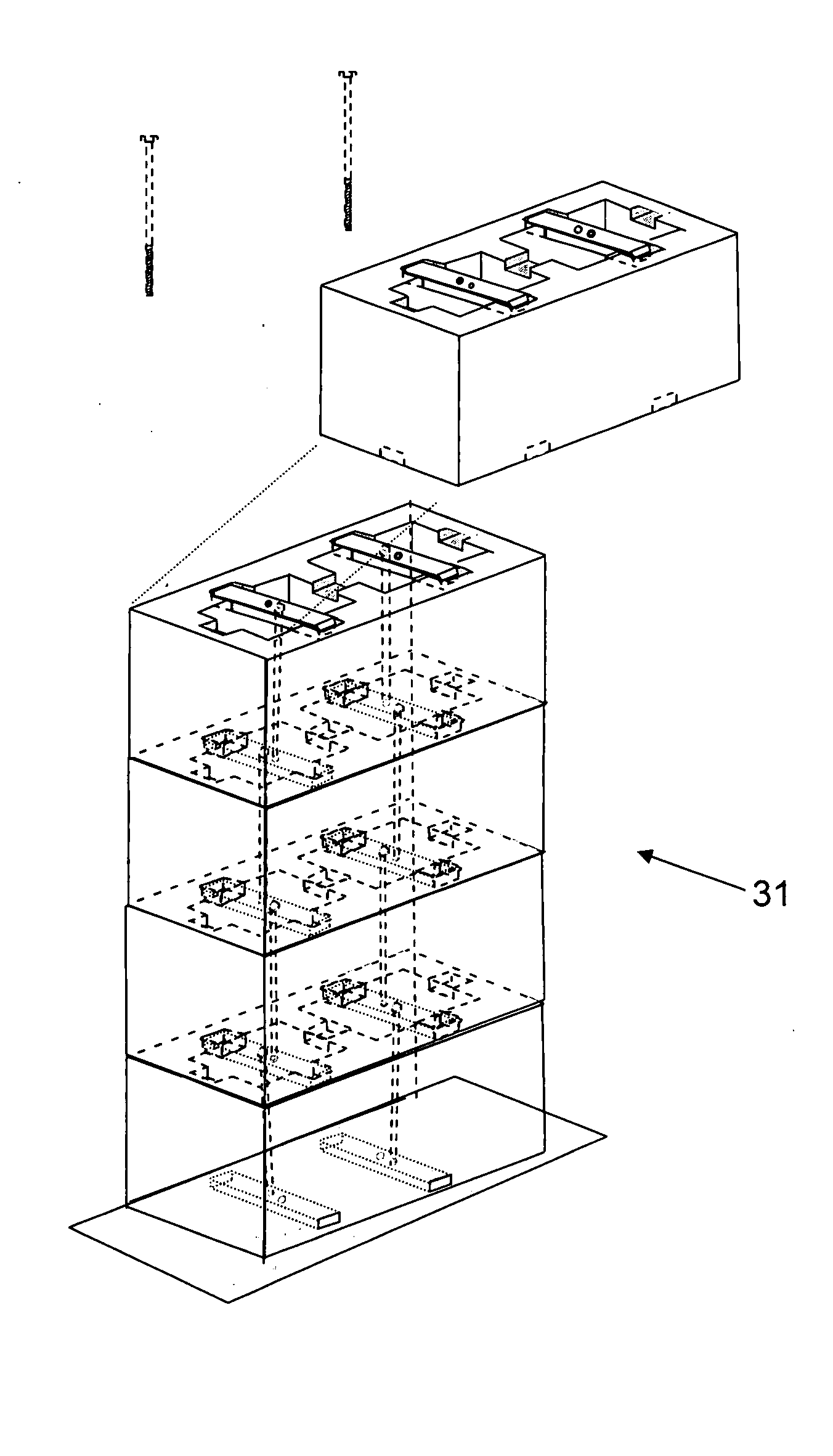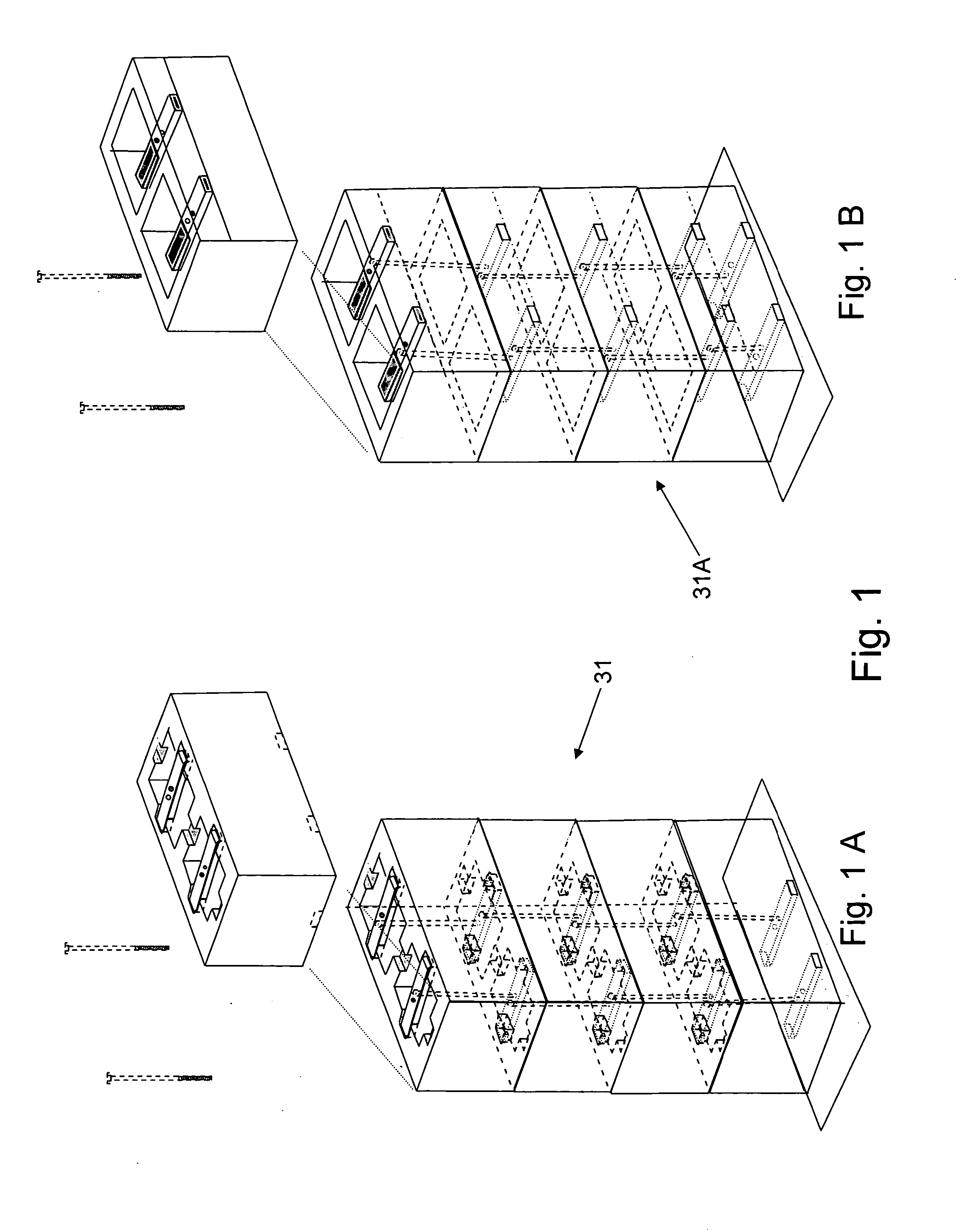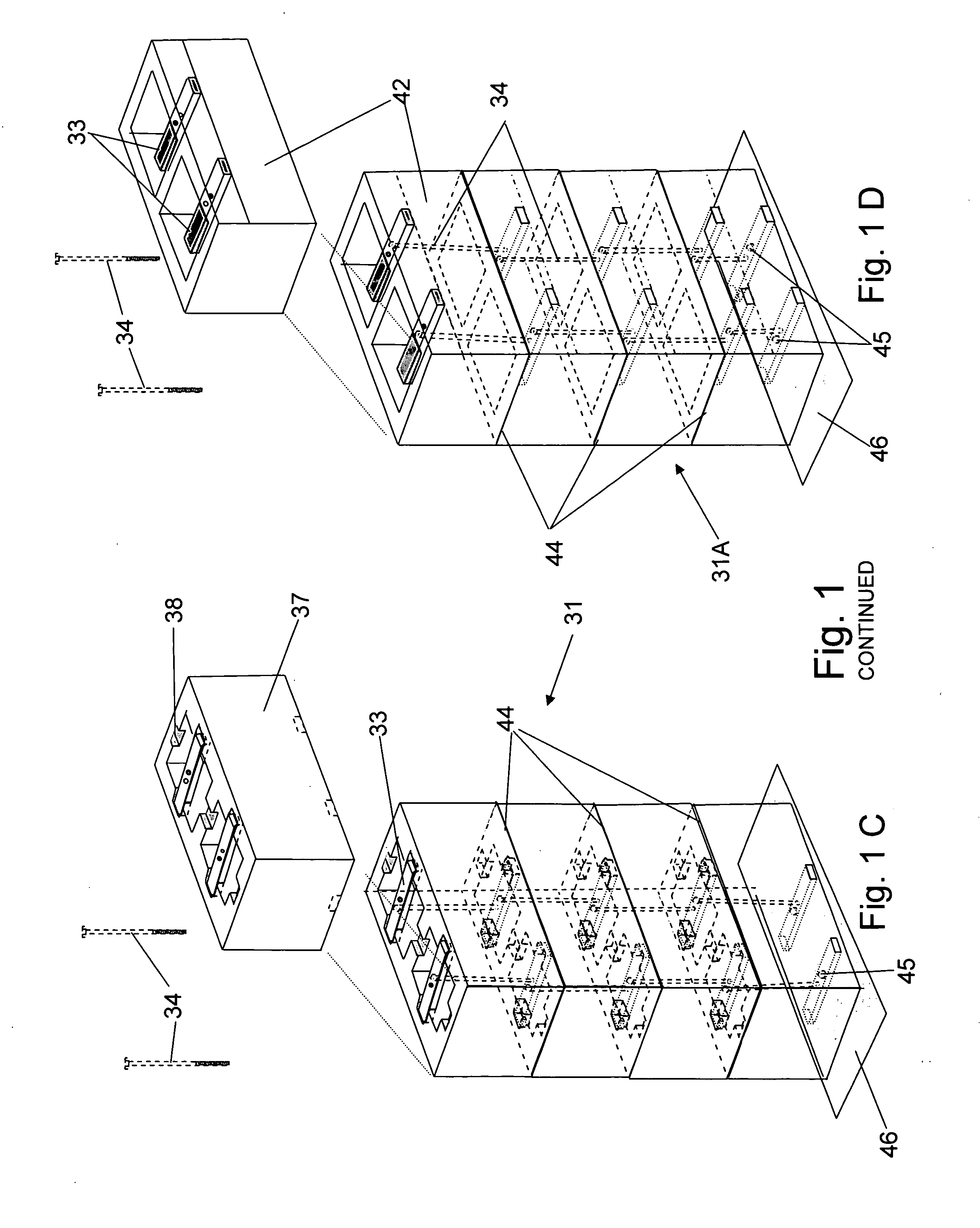[0034] There are many, many benefits and advantages of the UNITIZED POST TENSION BLOCK
SYSTEM FOR MASONRY STRUCTURES just as there were with the prior art described above. There currently exist no construction systems that use readily available parts and are so easy to perform. However, by having the unitized post tensioning technology, the structure is a far stronger unit than one built by traditional
mortar-using techniques. TABLE A shows a
list of advantages and benefits over the prior art Bolt-A-Block system. TABLE B shows the
list of advantages and benefits SIMILAR TO Bolt-A-Block for the advantages over traditional mortar and block systems. TABLE AADVANTAGES AND BENEFITS OVER A BOLT-A-BLOKSYSTEMITEMDESCRIPTION1
elimination of any gap between the CMUs. No fillingor caulking of the space is required.2precise placement of the anchor bar3faster build time with the recessed channels or theembedded bars4commercial tracking of the invention with the embeddedbars5stronger military / defense use and anti-blastapplications6features for easier, faster build with placement aids7features with anti-turn and quick connections withoval plates / washers and threaded tendons
[0035]TABLE BADVANTAGES SIMILAR TO BOLT-A-BLOKITEMDESCRIPTION1Is Waterless2Requires no wait time to get structural strength3Requires no temporary support while mortar cures and gainsstrength4Uses simple hand tools5Is Useful with / without footer6Has greater final tensile and
compressive strength thanmortar construction—is much stronger7Is Environmental friendly—Uses less wood, hence there isless
deforestation required to support construction8Has An improved total cost—material and unskilled labor9Permits rapid build.10Can be easily disassemble and components re-used.11Does not require skilled labor12Has Global / worldwide / universal applications13Can be built on soil or standard foundation14Spans greater distances between vertical double blocks15Is easy to learn the build concept and start building withnon-skilled workers. With this easy
learning curve, it issimple to learn and simple to use. So simple that multipleworkers may be in the same area—not “laying” block butassembling a structure16Provides perfect spacing which means more attractive walls.Blocks have perfect alignment and correct placement beforetightening17Reduces fire insurance and wind insurance costs18Uses existing modular sizes, worldwide.19Is an all weather construction. All kinds of weather,rain,
snow, wind, cold, hot,
underwater, even in a divingbell or
caisson20Is a Unitized construction. If one stops or anythinginterrupts the build at any point, one can resumeimmediately without the former problems of mortar dryingout and the other messy problems.21May build a wall by working from either side. Inside oroutside.22Works with one or more core block,
brick, and otherbuilding units23Requires less scaffolding, ladder jacks and walk boardsbecause the walls are immediately at full strength.24Can pour concrete in cores and even add vertical
rebar's.25Can pour insulation or
spray foam in cores.26Resists
flying debris.27Resists Earthquake and Hurricane /
tornado.28Is fire resistant.29Is not dependent on mortar strength30Requires no power or
gasoline to build31Is useable with other construction techniques—door andwindow frames, roof and ceiling joists and trusses; metaland
asphalt /
fiber / rubber roofing;32Is useable with standard plumbing, electrical,communications and lighting packages33Has the ability to construct several block
layers at onetime—speeds overall construction34Adapts to regular interior (plaster, boars, panel, paint)and exterior wall surfaces (siding,
brick,
stucco, etc)35Provides perfect plumb and level alignment36Does not require poured foundations37Is a Unit by unit construction38The simple bar and bolt is easily
mass produced usingexisting materials and equipment.39Is possible for the builder to leave out a small portion ofthe foundation wall so that trucks and backhoes can easilycross into the structure to grade, spread stone, unloadconcrete or do whatever is necessary. As soon as the heavyinside work is completed, the wall is quickly bolted intoplace and is ready to go, at full strength.46Provides a
mass that is so strong, and the total weight ofa UNITIZED POST TENSION BLOCK
SYSTEM FOR MASONRY STRUCTURESbuilding is of such significant weight, that below groundfreezing may largely only push sideways.47May be combined with a pre-constructed bath and / or kitchenunit.48Is termite and carpenter
ant proof.
[0035]TABLE BADVANTAGES SIMILAR TO BOLT-A-BLOKITEMDESCRIPTION1Is Waterless2Requires no wait time to get structural strength3Requires no temporary support while mortar cures and gainsstrength4Uses simple hand tools5Is Useful with / without footer6Has greater final tensile and
compressive strength thanmortar construction—is much stronger7Is Environmental friendly—Uses less wood, hence there isless
deforestation required to support construction8Has An improved total cost—material and unskilled labor9Permits rapid build.10Can be easily disassemble and components re-used.11Does not require skilled labor12Has Global / worldwide / universal applications13Can be built on soil or standard foundation14Spans greater distances between vertical double blocks15Is easy to learn the build concept and start building withnon-skilled workers. With this easy
learning curve, it issimple to learn and simple to use. So simple that multipleworkers may be in the same area—not “laying” block butassembling a structure16Provides perfect spacing which means more attractive walls.Blocks have perfect alignment and correct placement beforetightening17Reduces fire insurance and wind insurance costs18Uses existing modular sizes, worldwide.19Is an all weather construction. All kinds of weather,rain,
snow, wind, cold, hot,
underwater, even in a divingbell or
caisson20Is a Unitized construction. If one stops or anythinginterrupts the build at any point, one can resumeimmediately without the former problems of mortar dryingout and the other messy problems.21May build a wall by working from either side. Inside oroutside.22Works with one or more core block, brick, and otherbuilding units23Requires less scaffolding, ladder jacks and walk boardsbecause the walls are immediately at full strength.24Can pour concrete in cores and even add vertical
rebar's.25Can pour insulation or
spray foam in cores.26Resists
flying debris.27Resists Earthquake and Hurricane /
tornado.28Is fire resistant.29Is not dependent on mortar strength30Requires no power or
gasoline to build31Is useable with other construction techniques—door andwindow frames, roof and ceiling joists and trusses; metaland
asphalt /
fiber / rubber roofing;32Is useable with standard plumbing, electrical,communications and lighting packages33Has the ability to construct several block
layers at onetime—speeds overall construction34Adapts to regular interior (plaster, boars, panel, paint)and exterior wall surfaces (siding, brick,
stucco, etc)35Provides perfect plumb and level alignment36Does not require poured foundations37Is a Unit by unit construction38The simple bar and bolt is easily
mass produced usingexisting materials and equipment.39Is possible for the builder to leave out a small portion ofthe foundation wall so that trucks and backhoes can easilycross into the structure to grade, spread stone, unloadconcrete or do whatever is necessary. As soon as the heavyinside work is completed, the wall is quickly bolted intoplace and is ready to go, at full strength.46Provides a mass that is so strong, and the total weight ofa UNITIZED POST TENSION BLOCK
SYSTEM FOR MASONRY STRUCTURESbuilding is of such significant weight, that below groundfreezing may largely only push sideways.47May be combined with a pre-constructed bath and / or kitchenunit.48Is termite and carpenter
ant proof.
[0006] When reinforcement means have been used with block, it is typically accomplished with either long rebars or long steel rods or stranded cables placed in the cavities called ducts. The usual reinforcement is without any tensioning of the steel reinforcement, either pre-tensioning or post tensioning.
Pre and post tensioning, as one well skilled in the art of
construction engineering and techniques knows, increases the overall strength of the concrete unit. Until recently, post tensioning has only been used with a complete stack of block in conjunction with the placement of mortar between each layer. Up to now, most
specialty block systems with rods and plates have required very complex design and high levels of skill by construction designers and engineers.
[0036] For one skilled in the art of construction of structures, especially masonry, concrete, and
steel structures, it is readily understood that the features shown in the examples with this system are readily adapted to other types of construction improvements.
 Login to View More
Login to View More  Login to View More
Login to View More 


